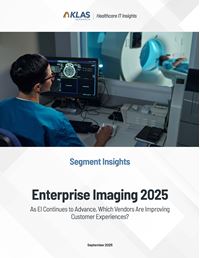 2025 BEST IN KLAS
2025 BEST IN KLAS
Preferences
Related Series
Related Segments


Enterprise Imaging 2021
A Deep Dive on the Market Landscape
As their enterprise imaging (EI) strategies mature, many healthcare organizations are looking to consolidate their imaging portfolio to save money, simplify IT support, and achieve better and easier access to images and data. Choosing the right imaging partner (or partners) is critical to long-term EI success. This report aims to help organizations choose vendors aligned with their goals and needs through insights on EI market share†, breadth of coverage, and typical customer profile.
Note: For the purposes of this research, KLAS defines enterprise imaging as the ability to store and/or view images across the enterprise from more than one service line, PACS, or long-term storage solution. This report focuses on VNA and UV solutions; click here for insights on image exchange solutions (not part of this report but another important EI component).
† The market share data in this report comes from a combination of provider organization interviews, vendor-reported information, KLAS Decision Insights, and publicly available information. In all cases, KLAS makes a best-effort attempt to use third-party sources and our vast provider network to independently validate vendor-claimed enterprise imaging contracts. While KLAS believes the data in this report is directionally correct, we acknowledge that some variation may exist.
Relationships Improving from Market Share Leader IBM Watson Health; GE Healthcare Sees Waning Loyalty from Poor Relationships
IBM Watson Health has high market share and deep adoption thanks to their broad imaging suite and strategic EI guidance. About one-third of enterprise deployments are in organizations with high radiology imaging volumes‡ (mostly 1M studies/year, largest validated at 12M), and customers plan to expand deployments. Since IBM acquired their solutions, respondents say communication has been poor; however, IBM’s recent reinvestment in account management is driving improvements in relationships and executive involvement. Customers want more hands-on training and development better aligned with their needs. GE Healthcare has a large base of VNA and UV deployments, though they are often departmental and not used in the context of EI. Respondents using GE Healthcare for EI are midsize, though KLAS has previously validated several large clients. Customer loyalty and purchase energy are low due to lacking development and poor client relationships. Current customers report GE Healthcare has struggled to deliver high-quality, timely support. In early 2021, InsiteOne re-acquired Unified Clinical Archive from NTT DATA (originally developed under InsiteOne before multiple ownership changes). The solution has been losing market share for some time; customers cite poor development, older architecture, and service and support challenges. Respondents express early optimism about the move to InsiteOne.
‡ Imaging volumes shared throughout are specific to radiology studies in the organization’s PACS (typically but not always from the same vendor providing their VNA and/or UV). This information is meant to provide a benchmark for the size of the organization but does not convey the exact number of studies being stored in the VNA or viewed in the UV (information KLAS does not measure). Organizations that have additional service lines connected to their VNA or UV will have higher total imaging volumes.

Agfa HealthCare’s Scalability Attracts High-Volume Customers; Fujifilm and Philips Mainly Validated for Small/Midsize Organizations
Almost half of Agfa HealthCare’s EI customers have radiology imaging volumes of >1M studies/year, with the largest at about 6M. Agfa’s solutions are described as reliable and easy to use. Respondents want to see faster development and more strategic guidance. Fujifilm and Philips have high energy among mostly small to midsize organizations (200K-400K radiology studies/year). Fujifilm’s acquired, standalone VNA is viewed by Fuji’s PACS customers and non-PACS customers as a stable, reliable option. Respondents want to see faster development and support response times. Fuji markets a universal viewer not yet validated by KLAS. The Carestream solutions acquired by Philips, whose footprint is larger outside the US, are highly reliable, cost effective, and simple for organizations to deploy on their own. Customers in the US tend to have less-complex needs than other vendors’ clients. Philips’ implementation quality is inconsistent, and some clients report nickel-and-diming.
Universal Viewer
Visage Has Highest Proportion Using Diagnostic Viewing; Hyland Validated for Most Service-Line Connections (Primarily Referential)

VNA
Fuji’s Strong Service-Line Integration Drives Broad Deployments; Lingering Issues Connecting to Other Fuji Solutions
Fujifilm and Sectra customers report more service-line connections to the VNA, though for different reasons. Fuji’s VNA is described by customers as reliable and stable. While most VNA deployments are at organizations with midsize radiology imaging volumes, organizations with higher volumes (1M studies/year) say the solution can scale to their needs. Customers see Fuji as fairly tactical and say the vendor’s growth will depend on how well they break down existing silos between their imaging departments to facilitate better integration and development. Sectra’s market share in the US remains low, partly because the VNA is not marketed as a standalone solution. Current customers report the vendor supports their platform consolidation strategies and is actively developing to meet client needs.

Growth beyond Radiology & Cardiology: POC Ultrasound, Wound Care, Pathology Most Broadly Adopted across Vendors
Outside of radiology and cardiology, point-of-care ultrasound, wound care, and pathology are the most often connected service lines. Respondents also frequently report connecting pathology, scopes (GI, ENT, & surgery), ophthalmology, and orthopedic surgery. The following charts are based on customer-reported data and are not meant to be comprehensive of all of a vendor’s clients.
Universal Viewer
Overall, organizations are reporting a larger set of connected service lines outside radiology, suggesting progress for EI (though still with significant room for growth). All vendors offering a universal viewer have interviewed customers using them for POC ultrasound and/or wound care. Hyland is validated for a very broad set of connected service lines. Notably, clients mention selecting NilRead specifically for its GI workflow and its ability to handle video editing for endoscopy.

VNA
Customers of Philips and Sectra (both with smaller market shares) report relatively higher rates of VNA adoption for POC ultrasound than other vendors (Fujifilm and GE Healthcare both have moderately strong adoption). IBM Watson Health and Fujifilm are validated for the widest range of specialties, though with lower adoption rates. While adoption rates are lower, areas such as scopes (GI, ENT, & surgery), pathology, and ophthalmology are in use across most vendors.

A Note about Cloud Technology:
Cloud technology is a commonly asked-about topic in reference to VNA and UV solutions. To learn more about imaging in the cloud, see KLAS’ recent report on the subject.
About This Report
The data in this report comes from two sources: (1) KLAS’ standard performance data along with supplementary questions asked specifically for this report, and (2) vendor market share data.
Performance Data
Each year, KLAS interviews thousands of healthcare professionals about the IT solutions and services their organizations use. For this report, interviews were conducted over the last 12 months using KLAS’ standard quantitative evaluation for healthcare software, which is composed of 16 numeric ratings questions and 4 yes/no questions, all weighted equally. Combined, the ratings for these questions make up the overall performance score, which is measured on a 100-point scale. The questions are organized into six customer experience pillars—culture, loyalty, operations, product, relationship, and value.

Sample Sizes
Unless otherwise noted, sample sizes displayed throughout this report (e.g., n=16) represent the total number of unique customer organizations interviewed for a given vendor or solution. However, it should be noted that to allow for the representation of differing perspectives within any one customer organization, samples may include surveys from different individuals at the same organization. Ratings from these individuals are aggregated in order to prevent any one organization’s feedback from disproportionately impacting a solution’s score. The table below shows the total number of unique organizations interviewed for each vendor or solution as well as the total number of individual respondents.

Some respondents choose not to answer particular questions, meaning the sample size for any given vendor or solution can change from question to question. When the number of unique organization responses for a particular question is less than 15, the score for that question is marked with an asterisk (*) or otherwise designated as “limited data.” If the sample size is less than 6, no score is shown. Note that when a vendor has a low number of reporting sites, the possibility exists for KLAS scores to change significantly as new surveys are collected.
Market Share Data
The market share data in this report is based on VNA and universal viewer purchases in the United States as of June 2021. This data comes from a combination of provider organization interviews, vendor-reported information, KLAS Decision Insights, and publicly available information. In all cases, KLAS makes a best-effort attempt to use third-party sources and our vast provider network to independently validate vendor-claimed enterprise imaging contracts. While KLAS believes the data in this report is directionally correct, we acknowledge that some variation may exist.
Product Designations Used in This Report
Component [C]: Product that typically includes most but not all components that comprise a complete system or that serves only a subset of the market. Sectra VNA is marked as component in this report because it is not marketed as a standalone solution.

Writer
Amanda Wind

Designer
Natalie Jamison

Project Manager
Jill Wilcock
This material is copyrighted. Any organization gaining unauthorized access to this report will be liable to compensate KLAS for the full retail price. Please see the KLAS DATA USE POLICY for information regarding use of this report. © 2026 KLAS Research, LLC. All Rights Reserved. NOTE: Performance scores may change significantly when including newly interviewed provider organizations, especially when added to a smaller sample size like in emerging markets with a small number of live clients. The findings presented are not meant to be conclusive data for an entire client base.














